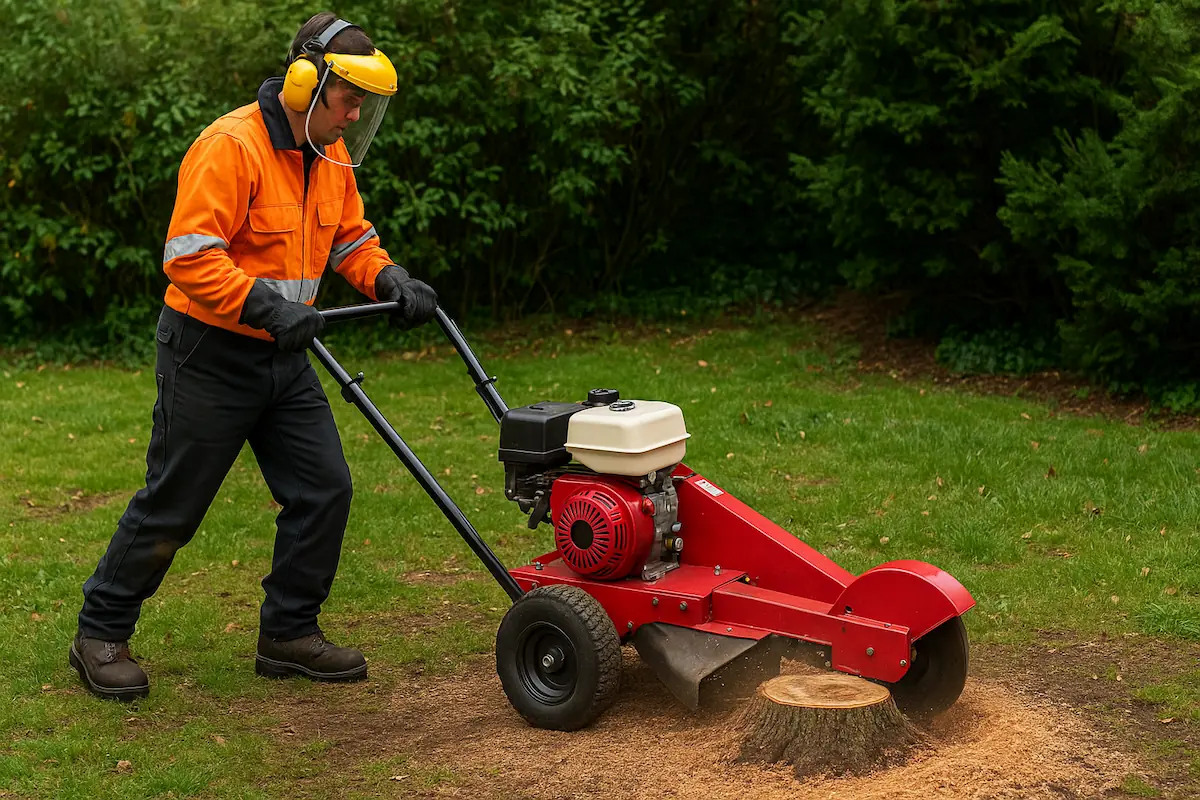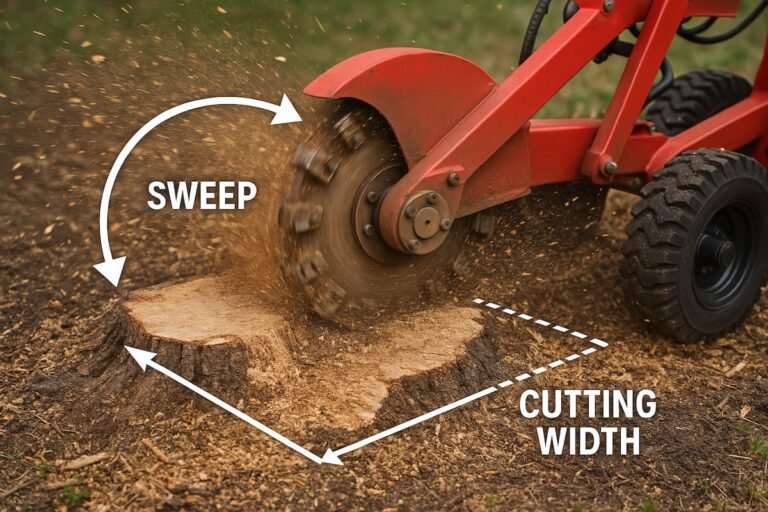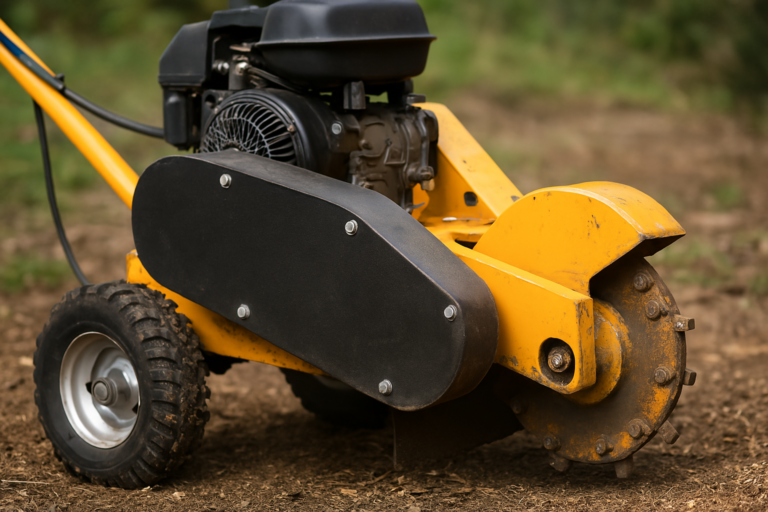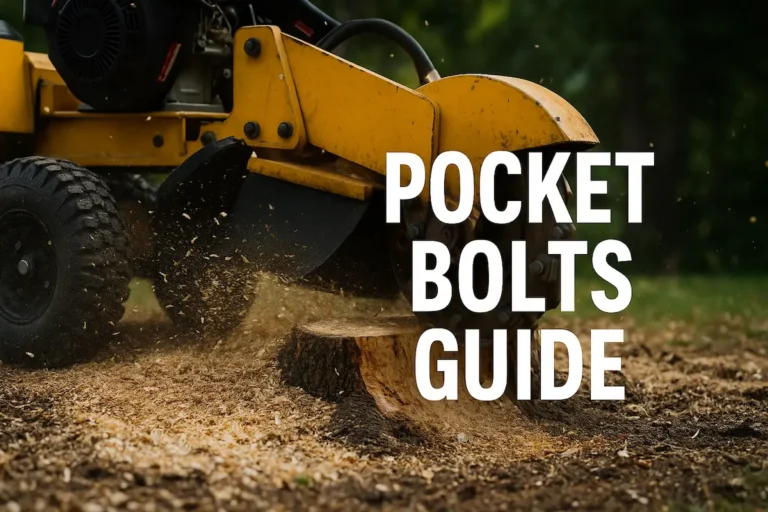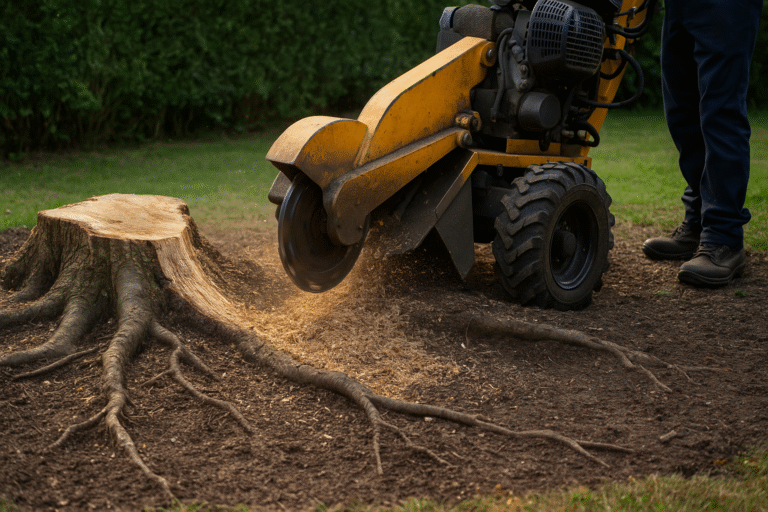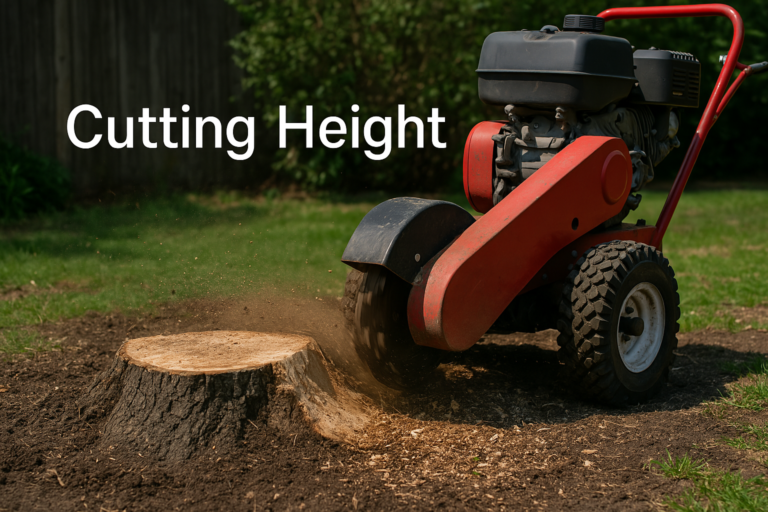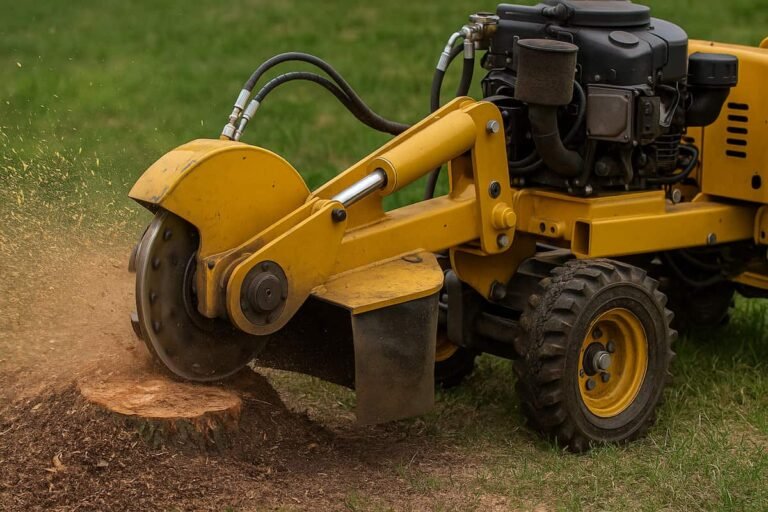Manual Sweep Stump Grinder Hire: Your Guide to Effort vs. Cost
Need to remove annoying tree stumps?
A manual sweep stump grinder could be your answer.
You push and pull this machine yourself to grind the stump away.
It often costs less to hire but needs your physical effort.
Perfect for small stumps, tight garden spots, and saving money.
Manual vs. Hydraulic Sweep Stump Grinder: Key Differences
Key Takeaways from the Chart
- The chart visually compares Manual Sweep and Hydraulic Sweep stump grinders across key factors based on a 1-5 rating (1=Low/Poor, 5=High/Good).
- Manual Sweep Grinders (Blue): Excel in ‘Low Hire Cost’ and ‘Tight Access Fit’. Score low on ‘Low Physical Effort’, ‘Large Stump Ability’, and ‘High Speed’ due to requiring operator strength and being slower.
- Hydraulic Sweep Grinders (Red): Score highly on ‘Low Physical Effort’, ‘Large Stump Ability’, and ‘High Speed’ using powered hydraulics. Drawbacks are higher cost (‘Low Hire Cost’ score is low) and reduced suitability for very tight spaces (‘Tight Access Fit’ score is lower).
- Choosing the Right Grinder: Manual is budget-friendly for small jobs/tight access if physical work is acceptable. Hydraulic is better for larger/multiple stumps or minimizing effort/time, if access and budget allow.
Understand What "Manual Sweep" Means for Stump Grinding
"Manual sweep" means you control the grinder's side-to-side movement.
Think of it like swinging the machine back and forth yourself.
Use the handlebars to push or pull the cutting wheel across the stump.
There are no powered hydraulics doing this swinging for you.
It requires direct physical work from you, the operator.
This is different from bigger machines that swing automatically.
Compare Key Differences: Manual Sweep vs. Hydraulic Sweep Grinders
Choosing the right stump grinder is essential for your project.
Manual sweep and hydraulic sweep grinders work differently.
Manual sweep grinders need your muscles to move side-to-side.
Hydraulic sweep grinders use powered controls, like joysticks, for movement.
This makes hydraulic grinders much easier and faster on big stumps.
But manual sweep grinders have their advantages.
They are usually smaller and lighter.
This makes them great for getting into tight garden spaces.
Manual grinders often cost less per day or week to hire.
Hydraulic grinders are heavier and need more space.
They cost more to hire but save time and effort on large jobs.
Here’s a simple table showing the main differences:
| Feature | Manual Sweep Grinder | Hydraulic Sweep Grinder |
|---|---|---|
| Sweep Control | Operator Pushes/Pulls Handles | Machine Powered (Joystick/Levers) |
| Power Source | Petrol Engine (for cutting wheel) | Petrol/Diesel Engine (cuts & sweeps) |
| Typical Size | Smaller, Walk-Behind | Larger, Walk-Behind or Tracked |
| Effort Level | High Physical Effort Needed | Low Physical Effort Needed |
| Hire Cost | Lower | Higher |
| Best Use Case | Small/Medium Stumps, Tight Access | Medium/Large Stumps, Multiple Stumps |
Understanding these differences helps you pick the best hiring tool.
Decide if Manual Sweep Grinder Hire Fits Your Project
Is a manual sweep grinder the right choice for you?
Think about these points before you decide to hire:
- Stump Size and Wood Type:
- Manual grinders work best on smaller stumps.
- Think stumps less than about 15-20 inches across (38-50 cm).
- They handle softer woods like pine or fir easier than hardwood.
- Hardwoods like oak or beech take much more time and effort.
- One user on a forum said, "Don't try a manual sweep on a huge oak stump unless you have lots of time and energy."
- Number of Stumps:
- Grinding one or two small stumps is usually fine.
- Tackling many stumps (5+) with a manual grinder gets very tiring.
- Consider how much work you want to do in one day.
- A DIY hirer mentioned, "I rented a manual grinder for 10 small pine stumps. It took all day and killed my back, but I saved £300 over hiring a pro."
- Access Restrictions:
- Can you easily get machinery to the stump?
- Manual sweep grinders often fit through standard garden gates (check dimensions!).
- Their lighter weight (around 100-250 kg) helps on paths or lawns.
- A manual grinder might be your only option if access is very narrow.
- A landscaper commented online: "The manual walk-behind is sometimes the only option for tight gates. It's slow but pays the bills."
- Your Budget:
- Manual sweep grinders are typically the cheapest hire option.
- If saving money is your primary goal, this is a big plus.
- Compare daily or weekly hire rates against hydraulic models.
- Your Physical Ability:
- This is very important. Be honest with yourself.
- Operating a manual sweep grinder requires good upper body strength.
- You need stamina to push and pull the machine repeatedly.
- It feels like a challenging workout, similar to using a heavy rototiller.
- Consider another option if you have back problems or aren't physically fit.
- Many instructional videos show operators bracing themselves and using body weight.
Quick Checklist:
- Stumps mostly under 15 inches? (Good fit)
- Only a few stumps (1-4)? (Good fit)
- Tight garden gate or path access? (Good fit)
- On a tight budget? (Good fit)
- Ready for a physical workout? (Good fit)
A manual sweep grinder could be great if you answered 'yes' to most of these.
If you have large stumps or many stumps or aren't up for the effort, consider hydraulic options.
Discover the Advantages of Hiring a Manual Sweep Grinder
Manual sweep grinders offer some real benefits for specific jobs.
Benefit 1: Lower Hire Costs
Saving money is often a big reason people choose manual grinders.
They generally have the lowest daily or weekly hire price.
This makes stump removal more affordable for DIY projects.
You get the power of a grinder without the cost of a bigger machine.
Benefit 2: Excellent Access to Tight Areas
Do stumps near fences, walls, or down narrow paths?
Manual sweep grinders are usually smaller and lighter than hydraulic ones.
Typical weights range from 100kg to 250kg.
This means they can often fit through standard garden gates.
You can manoeuvre them into spots larger machines cannot reach.
This avoids needing to take down fences or walls for access.
Benefit 3: Simpler Operation (Mechanically)
These machines have fewer complex controls.
The main parts are the engine, cutting wheel, and handlebars.
There are no complicated hydraulic levers for the sweep motion.
Starting and basic operations are usually straightforward (always read instructions!).
However, remember that physical operation requires significant effort.
Benefit 4: Easier Transportation (Relatively)
Because they are lighter than hydraulic grinders, transport can be simpler.
Some models might fit in a large estate car or small van (check dimensions and weight!).
Many will still need a trailer for safe transport.
Always check the hire company's advice on transporting the specific model.
You need appropriate ramps and securing straps.
Never try to lift the machine beyond your capability.
Acknowledge the Considerations: The Reality of Manual Sweep
While they have benefits, you must understand the downsides, too.
Drawback 1: Significant Physical Effort Required
We cannot stress this enough: manual sweep grinding is hard work.
You provide the power for the side-to-side sweep.
This needs constant pushing and pulling on the handlebars.
It requires good upper body strength and stamina.
Users often report feeling it in their arms, shoulders, and back afterwards.
Testimonials frequently mention the effort:
"It's a workout," You feel it the next day, "Requires a strong back."
If you are not physically prepared, the job will be challenging.
It can lead to strain or injury if you overdo it or use poor technique.
Drawback 2: Slower Progress on Stumps
Grinding takes longer with a manual sweep machine.
You must take smaller "bites" with each pass across the stump.
Operator fatigue also slows things down; you will need breaks.
Large diameter stumps (over 15-20 inches) can take significant time.
Hardwood stumps resist the cutting wheel more, slowing progress further.
Compared to hydraulic grinders, expect the job to take considerably longer.
Drawback 3: Limitations on Stump Size and Hardness
Manual sweep grinders have practical limits.
They are not designed for large stumps (e.g., over 20-24 inches).
While possible, it becomes incredibly time-consuming and exhausting.
Dense hardwoods like mature oak, beech, or elm are challenging.
The engine power (typically 13-27 HP) may struggle.
The operator effort required increases dramatically on tough stumps.
For very large or complex stumps, a hydraulic grinder is usually better.
Learn How a Manual Sweep Grinder Works
Understanding the basics helps you use the machine safely.
A petrol engine provides power.
This engine spins a cutting wheel fitted with sharp teeth.
The teeth are usually made of very hard tungsten carbide.
It's this fast-spinning wheel that chips away the wood.
The unique part is the manual sweep mechanism.
The machine often pivots on its wheels.
You, the operator, stand behind the handlebars.
You physically push and pull the handlebars side-to-side.
This swings the rotating cutting wheel across the face of the stump.
You control the speed and width of this sweeping arc.
Most models also have a way to control the cutting depth.
This might be a lever or a screw mechanism.
After each sweep, you can lower the wheel deeper into the stump.
You repeat sweeps, lowering the wheel each time until the stump is gone.
Operate Your Hired Manual Sweep Grinder: Step-by-Step Guide
Always read the specific instruction manual for the model you hire!
This guide gives general steps for safe operation.
Pre-Start Checks and Site Preparation
Safety first! Prepare the area properly.
Clear all rocks, stones, bricks, and loose debris around the stump.
These items can damage the grinder teeth or become dangerous flying objects.
Check for hidden obstacles like metal pipes or old concrete.
Mark the location of any known underground utilities (pipes, cables). Call before you dig if you are unsure!
Ensure you have a clear, stable area to stand and work.
Keep children and pets far away from the work zone.
Check the grinder's fuel (usually petrol) and oil levels.
Inspect the cutting teeth for damage or excessive wear—report issues to the hire company.
Essential Safety Gear (PPE)
Wearing the correct Personal Protective Equipment (PPE) is mandatory.
Never operate a stump grinder without:
- Eye Protection: Safety goggles or a full-face visor are essential. Flying wood chips and debris are a serious hazard.
- Hearing Protection: Stump grinders are loud. Use ear defenders or earplugs.
- Sturdy Footwear: Steel toe-capped boots are highly recommended. Avoid trainers or open shoes.
- Gloves: Heavy-duty work gloves provide grip and protect hands.
- Trousers: Wear thick work trousers (not shorts) to protect your legs. Chainsaw trousers offer extra protection.

Starting the Machine Safely
Follow the specific starting procedure in the machine's manual.
This usually involves:
- Ensure the cutting wheel is clear of the ground and the stump.
- Turn the fuel tap on (if applicable).
- Set the choke (if starting from cold).
- Turn the engine switch to 'ON'.
- Engage the operator presence control or safety bar (keeps the engine running).
- Pull the starter cord firmly.
- Adjust the choke as the engine warms up.
- Engage the clutch or mechanism to start the cutting wheel spinning (follow instructions!).
Positioning and Initial Cut
Carefully move the grinder towards the stump.
Position the cutting wheel just above the edge of the stump you want to start on.
Ensure you have stable footing before starting the cut.
Slowly lower the spinning cutting wheel onto the highest edge of the stump.
For the first pass, lower it only about 1/2 inch to 1 inch (1-2.5 cm) deep.
Performing the Manual Sweep
Now, you begin the side-to-side sweep.
Hold the handlebars firmly with both hands.
Use your arms and body weight to swing the cutting head across the stump face slowly.
Maintain a controlled, steady arc. Do not rush.
Listen to the engine; you are cutting too deep or fast if it labours.
Sweep the wheel thoroughly past one edge of the stump before reversing direction.
Overlap your sweeps slightly for an even grind.
Adjusting Depth and Completing the Grind
Stop the sweep motion after sweeping across the entire width of the stump.
Move the grinder slightly forward or adjust the depth control.
Lower the cutting wheel another 1/2 inch to 1 inch deeper.
Perform another full sweep across the stump at this new depth.
Repeat this process: sweep across, lower the wheel, and sweep back.
Continue until you reach the desired depth below ground level (usually 4-8 inches).
Grinding below ground ensures grass can grow back over the area.
Safe Shutdown Procedure
Move the grinder away from the stump area.
Disengage the cutting wheel clutch first (follow instructions!).
Allow the engine to idle for a short time to cool down.
Turn the engine switch to 'OFF'.
Turn the fuel tap off (if applicable).
Wait for all moving parts to stop completely before leaving the machine.
Clean excess wood chips off the machine (only when stopped and safe).
Master the Manual Sweep Technique for Efficiency and Safety
Using the proper technique makes the job easier, safer, and faster (relatively!).
Take Small, Controlled Bites
This is the golden rule for manual sweep grinding.
Only cut about 1/2 inch to 1 inch (1-2.5 cm) deep per sweep pass.
Trying to cut too deep puts an enormous strain on the machine and you.
It increases the risk of the grinder bouncing or kicking back.
It also slows you down as the engine struggles.
Small bites mean steady progress.
Use a Consistent Arcing Motion
Think of yourself as a pendulum.
Use your whole body, not just your arms, to create a smooth swing.
Keep a firm grip on the handlebars.
Maintain a slow, steady speed across the stump.
Avoid jerky movements.
Find a rhythm that works for you and the machine.
Manage Operator Fatigue
Manual grinding is tiring. Acknowledge this and plan for it.
Take regular breaks, especially when working on larger stumps or for long periods.
Step away from the machine, stretch, and have a drink.
Trying to push through fatigue leads to mistakes and poor technique.
Pacing yourself is crucial for completing the job safely.
If grinding multiple stumps, consider spreading the work over time.
Maintain Control: Avoid Bouncing
The grinder can bounce if you hit a hard root, rock, or sweep too fast.
Bouncing is dangerous as you can lose control.
Always keep a firm grip on the handlebars.
Maintain good balance and stable footing.
If the machine starts to bounce, immediately ease off the cutting pressure.
Let the cutting wheel regain speed before gently re-engaging.
Sweep slower and take even smaller bites if bouncing occurs.
Listen to the machine – the sound changes if it's struggling or hitting something hard.
Common Problems & Quick Solutions Summary
- Problem: Grinder Bouncing Violently
- Cause: Cutting too deep/fast, hitting complex roots/rocks.
- Solution: Stop sweeping, lift the wheel slightly, take smaller bites, and sweep slower. Check the area for hidden rocks.
- Problem: Engine Stalling or Labouring
- Cause: Cutting too deep/fast, blunt teeth.
- Solution: Lift the wheel and allow the engine to recover its speed. Take smaller bites. Check the condition of the teeth (report damage to the hire company).
- Problem: Slow Progress
- Cause: Taking too small bites, very hard wood, operator fatigue, blunt teeth.
- Solution: Ensure the correct bite size (1/2-1 inch), take breaks and check teeth. Accept that manual grinding is slower.
- Problem: Operator Getting Tired Quickly
- Cause: Physical nature of the work, poor technique (using only arms).
- Solution: Use the whole body for sweep, maintain good posture, and take frequent breaks. Ensure you're fit enough for the task.
Assess the Real Physical Effort Involved
Let's be clear: using a manual sweep grinder is hard physical work.
Many people underestimate the effort required until they try it.
Think about repeatedly pushing and pulling a heavy object (100-250kg) back and forth.
You are controlling the machine's movement against the resistance of the wood.
It requires significant upper body strength – arms, shoulders, back, and core.
Good stamina and endurance are also needed, especially for larger stumps.
People compare the effort to:
- Using a heavy petrol rototiller in tough soil.
- A prolonged session with a heavy sledgehammer.
- An intense upper-body gym workout.
Honestly assess your physical condition before hiring.
If you have any doubts about your strength or fitness, consider:
- Hiring a hydraulic sweep grinder (less effort).
- Hiring a professional stump grinding service.
Choosing the wrong machine for your physical ability can lead to frustration, exhaustion, or injury.
Prioritise Safety: Key Risks with Manual Sweep Grinders
Stump grinding has risks, and manual operation adds specific points to watch.
Safety must always be your top priority.
Key risks include:
- Flying Debris: The cutting wheel throws wood chips at high speed. Stones or metal hit by the wheel become dangerous projectiles. Eye protection is essential.
- Kickback / Bouncing: If the wheel hits something hard or you cut too aggressively, the machine can kick back towards you or bounce uncontrollably. Maintain a firm grip and control. Take small bites.
- Loss of Control: Fatigue, uneven ground, or bouncing can cause you to lose control of the machine. Stay alert, take breaks, and ensure stable footing.
- Contact with Cutting Wheel: The rotating wheel causes severe injury instantly. Keep hands and feet away. Wait for the wheel to stop completely before approaching. Use safety guards provided.
- Noise: Grinders are very loud and can damage hearing over time. Always wear hearing protection.
- Strain / Injury: The physical effort of manual sweep can cause muscle strains or back injuries if you use poor technique, overexert yourself, or are not physically prepared. Use the correct method, pace yourself, and know your limits.
- Underground Utilities: Hitting gas pipes, electric cables, or water pipes is dangerous and costly. Always check for utilities before grinding.
Mitigation is Key:
- Always wear the correct PPE. No excuses.
- Prepare the site thoroughly. Remove all debris.
- Read and follow the operator's manual.
- Use the correct technique (small bites, steady sweep).
- Maintain a firm grip and control at all times.
- Stay alert and focused. Avoid distractions.
- Take regular breaks to combat fatigue.
- Keep others far away from the operating area.
- Know your physical limits. Don't push yourself too hard.
If you feel uncomfortable or unsafe at any point, stop work.
See Ideal Projects for Manual Sweep Stump Grinders
These grinders shine in specific situations:
- Removing Small Garden Stumps: This tool is perfect for removing a few shrubs, hedges, or small tree stumps (e.g., privet, laurel, or small conifers) up to about 15 inches across.
- Stumps in Tight Spots: These are excellent for back gardens with narrow gate access where larger machines won't fit. They are also ideal for stumps near walls, fences, or pathways.
- Budget-conscious DIY: When you want to remove stumps and save money compared to hiring a professional or a larger hydraulic machine, you trade your effort for a lower cost.
- Occasional Use: Suitable for homeowners or landscapers who only need to grind stumps occasionally and don't face huge stumps regularly.
Example Scenario:
- Sarah had two old rose bush stumps and a small cherry tree stump (about 10 inches across) in her back garden. Access was through a standard 3-foot gate. She hired a manual sweep grinder for a day, worked a few hours, and successfully removed them, saving money compared to calling a tree surgeon. She found it tiring but manageable for the small number of stumps.
Know When to Choose a Hydraulic Grinder Instead
A manual sweep grinder isn't always the best tool.
Consider hiring a hydraulic sweep grinder if you have:
- Multiple Large Stumps: Grinding many stumps, especially those over 15-20 inches, is much faster and less tiring with hydraulic assistance.
- Very Dense Hardwood Stumps: Hydraulic grinders typically have more power and easily handle tough woods like oak or large beech stumps.
- Limited Time: A hydraulic grinder's speed is a significant advantage if you need the job done quickly.
- Physical Limitations: If you are unable or unwilling to perform the demanding physical work of manual sweeping, hydraulics is the way to go.
- Easy Access: If the site allows for a larger, heavier machine (wider gates, stable ground), a hydraulic grinder's efficiency might be worth the higher hire cost.
Think about the total cost vs. effort and time. Sometimes, paying more for hydraulic hire saves you hours of hard labour.
Hear From Our Hirers: Manual Grinder Experiences (Optional Section)
Testimonial 1:
"Hired the small manual grinder for three conifer stumps in my garden. The gate access was tight, but the machine fitted through perfectly. It took a good few hours and was hard work pushing it, but it did the job brilliantly. It saved me a fair bit compared to getting someone in. Happy with the result!"" - Mark D., Reading
Testimonial 2:
"Needed to remove an awkward stump right next to a patio wall. The manual sweep grinder was only small enough to get in there. It took patience and effort, especially swinging it, but it chipped the stump away neatly below ground level. Worth the hire cost for sure."" - Sarah P., Guildford
These experiences show the grinder works well for the right task but highlight the effort involved.
Summary: Your Manual Sweep Grinder Hire Checklist
Choosing the right grinder matters. Let's recap:
- Manual sweep grinders need your physical effort to swing side-to-side.
- They are of great value for hiring, saving you money.
- They excel at getting into tight-access gardens.
- It is best suited for smaller stumps (under 15-20 inches) and fewer stumps.
- Be honest about your physical fitness – it's demanding work!
- Always prioritise safety and wear the correct PPE.
- Consider a hydraulic grinder for larger jobs or, if you prefer, less effort.
Think carefully about:
- Stump size and wood type?
- How many stumps?
- Garden access width?
- Your budget?
- Your physical ability?
Answering these questions helps you make the best hiring decision.
Ready to Tackle Those Stumps? Hire Your Manual Sweep Grinder Today!
Now you understand manual sweep stump grinders.
If it sounds like the right tool for your project, we are here to help.
Hire your manual sweep stump grinder today!
✅ Affordable rates
✅ Reliable machines
✅ Friendly advice

